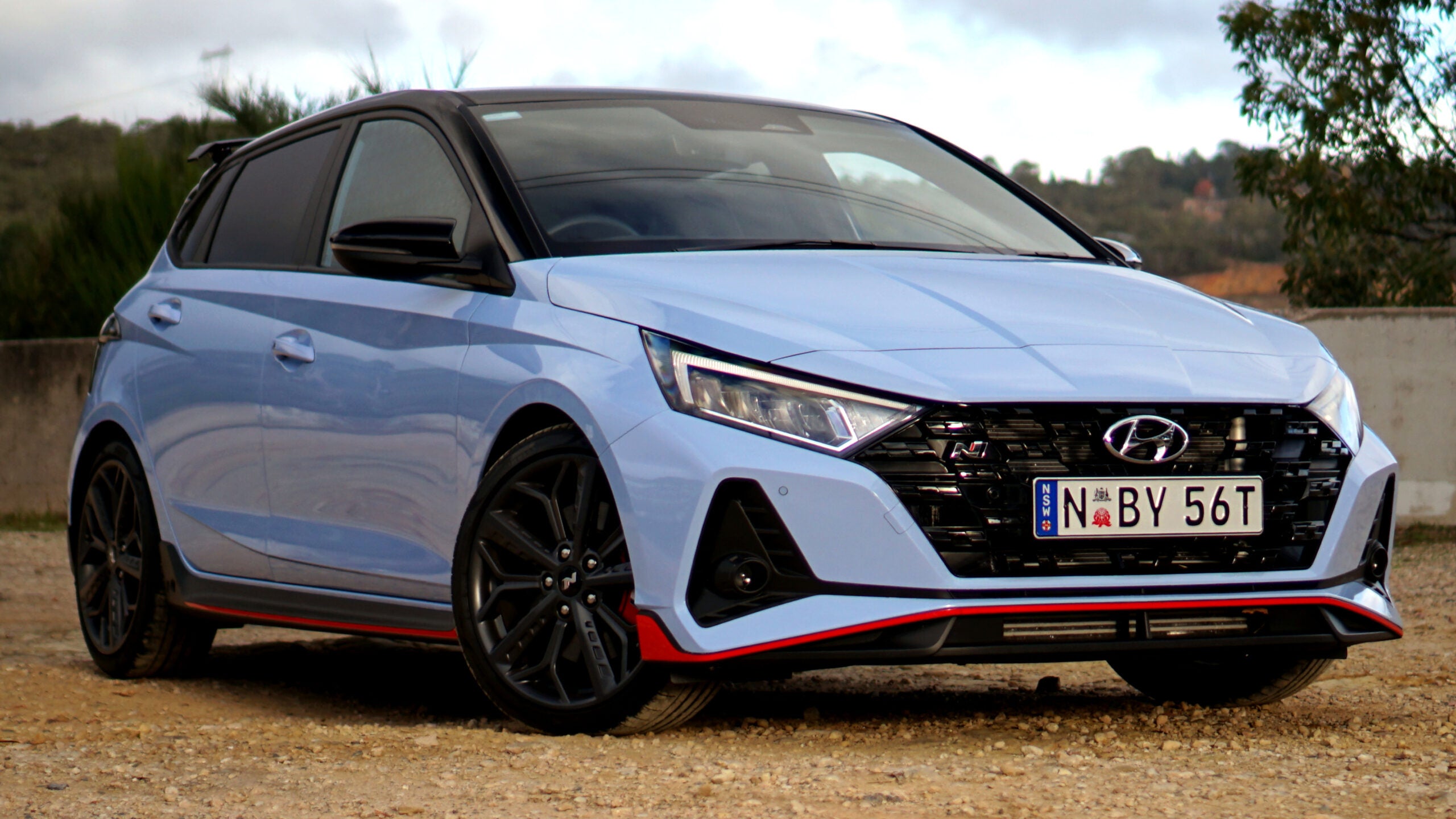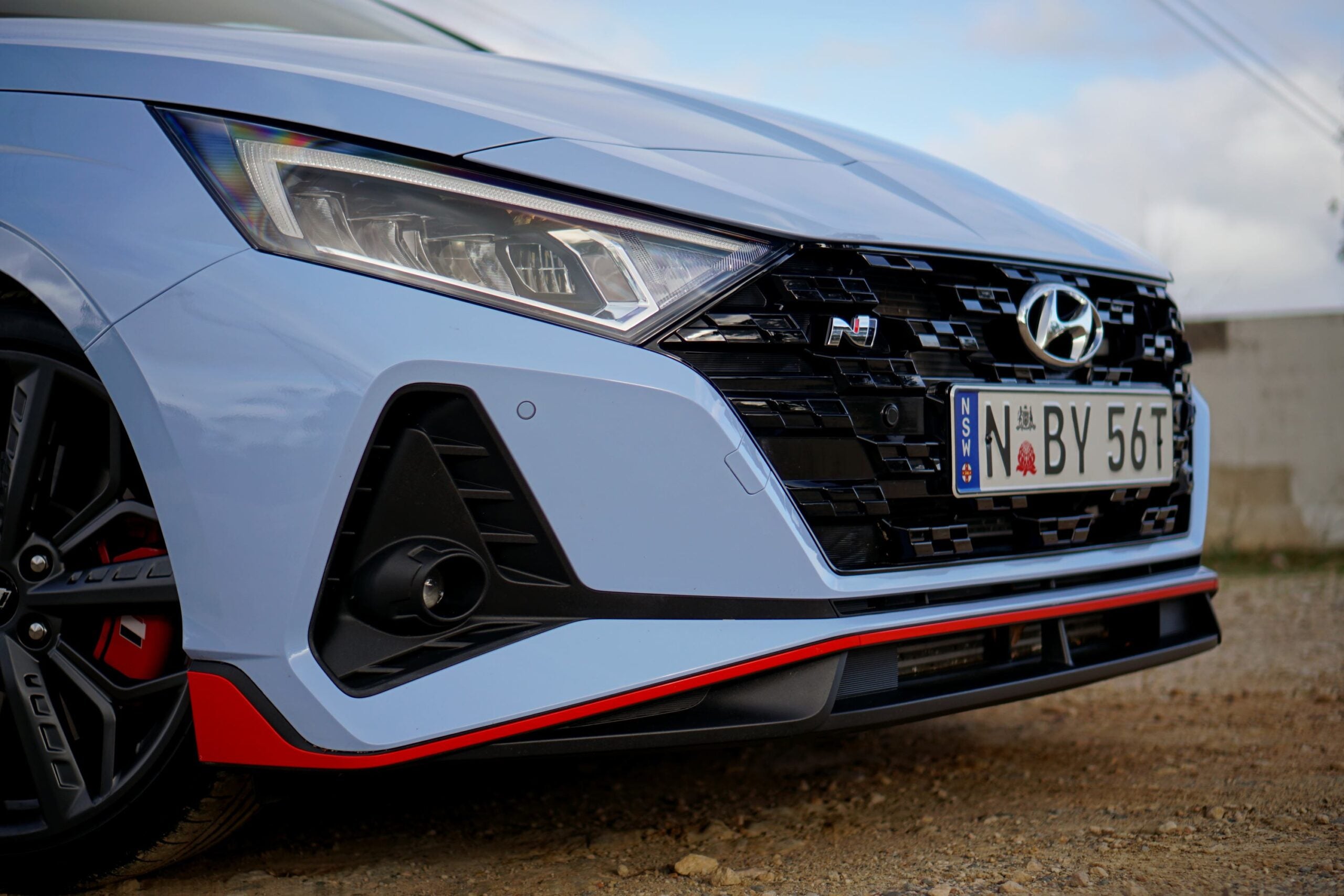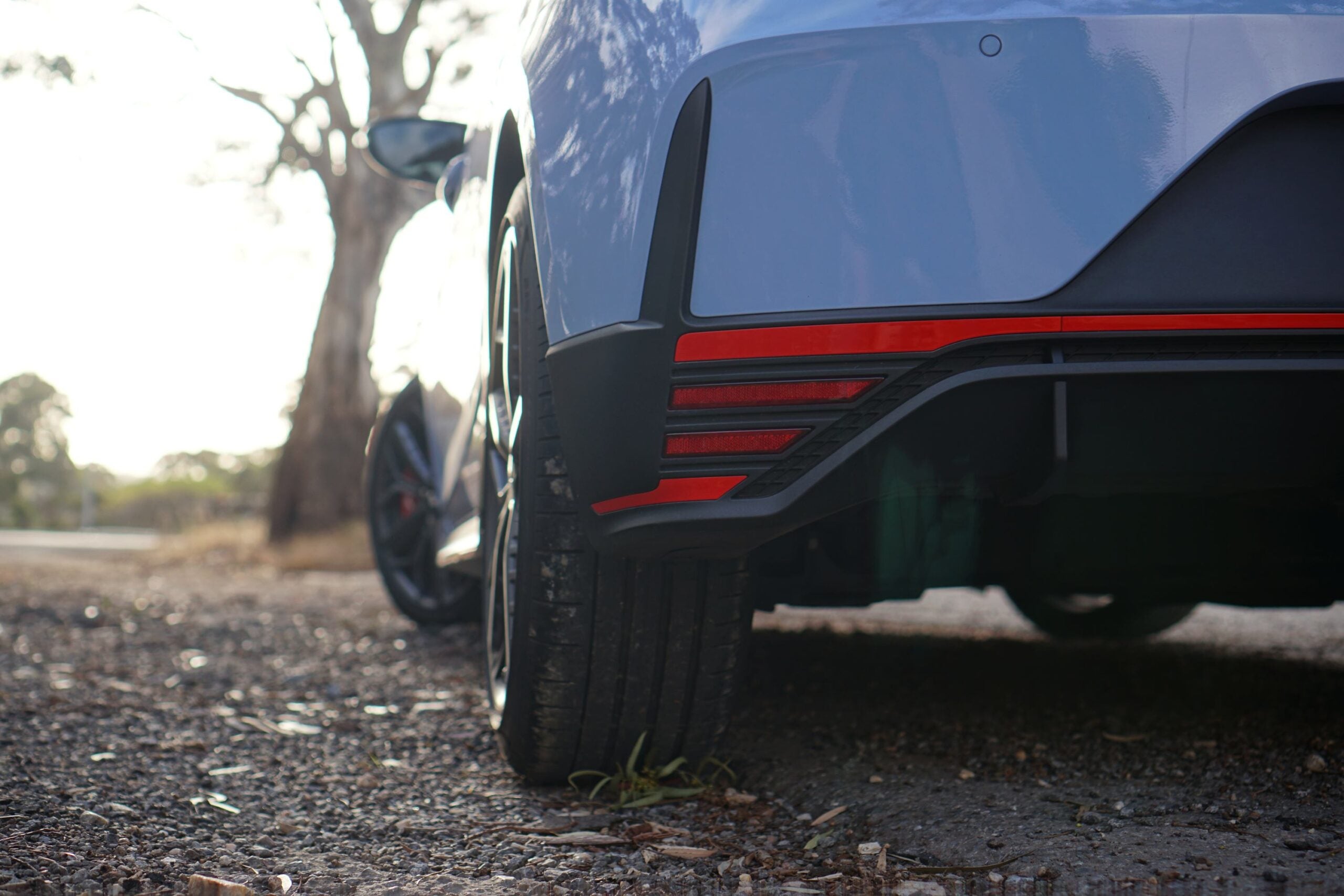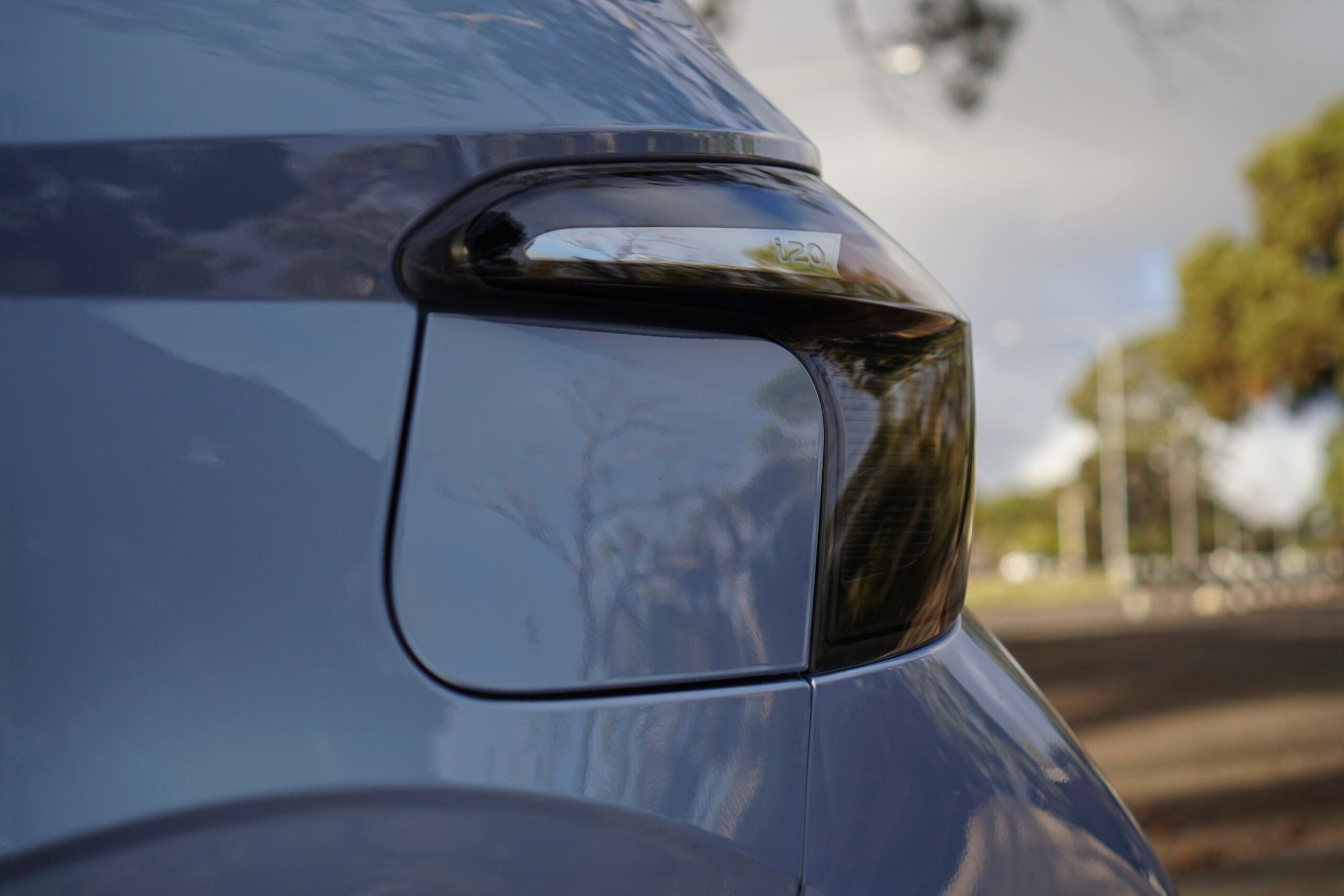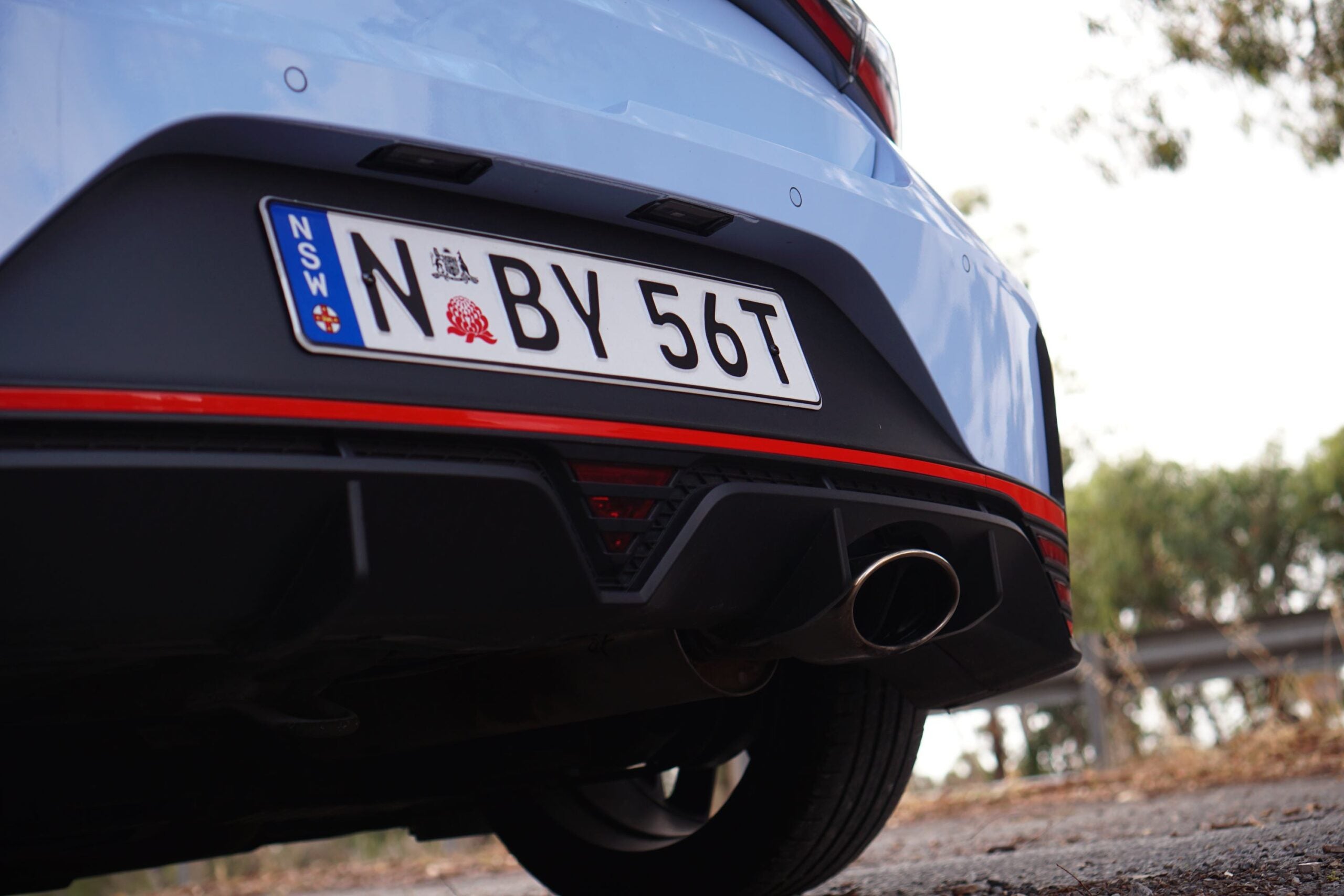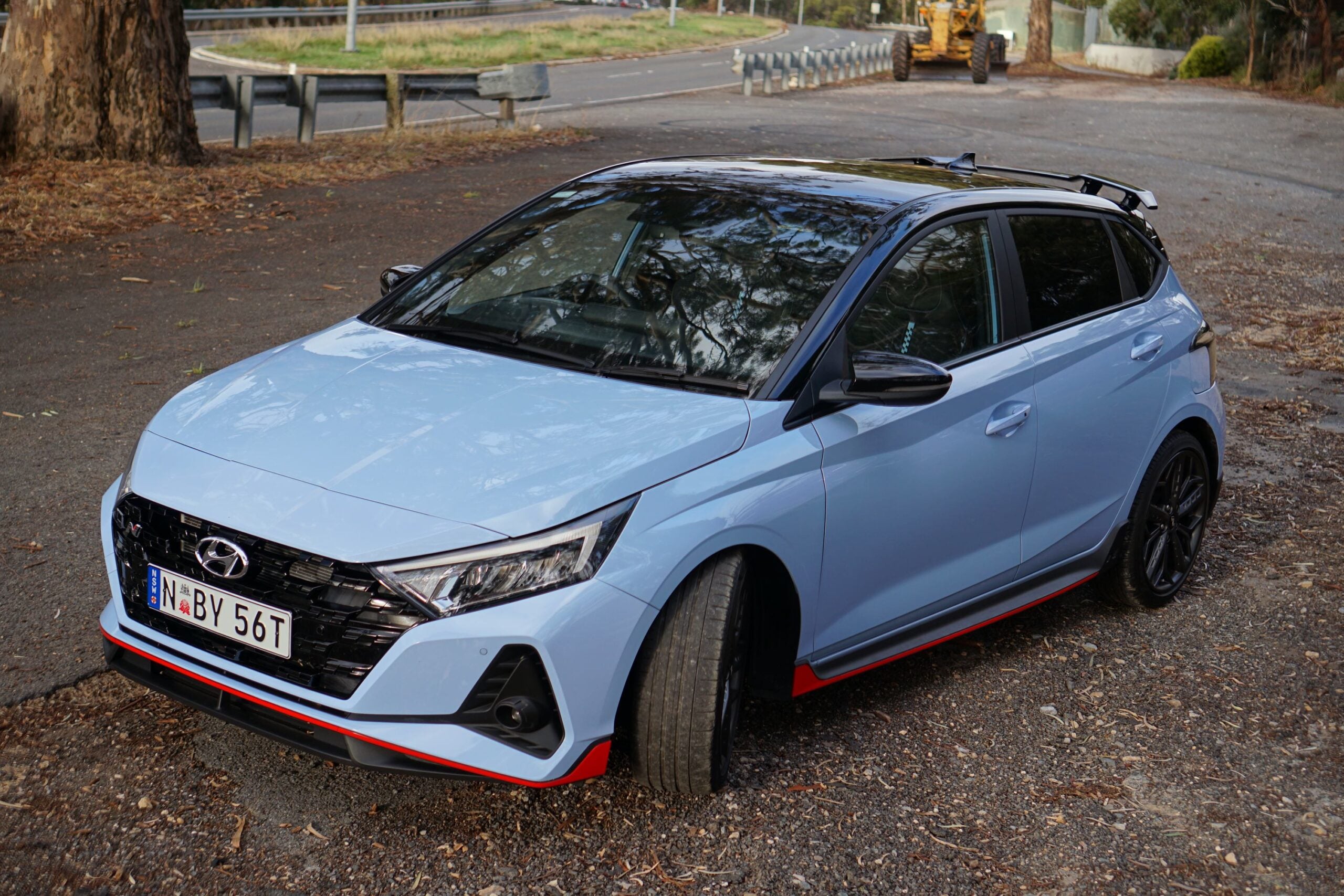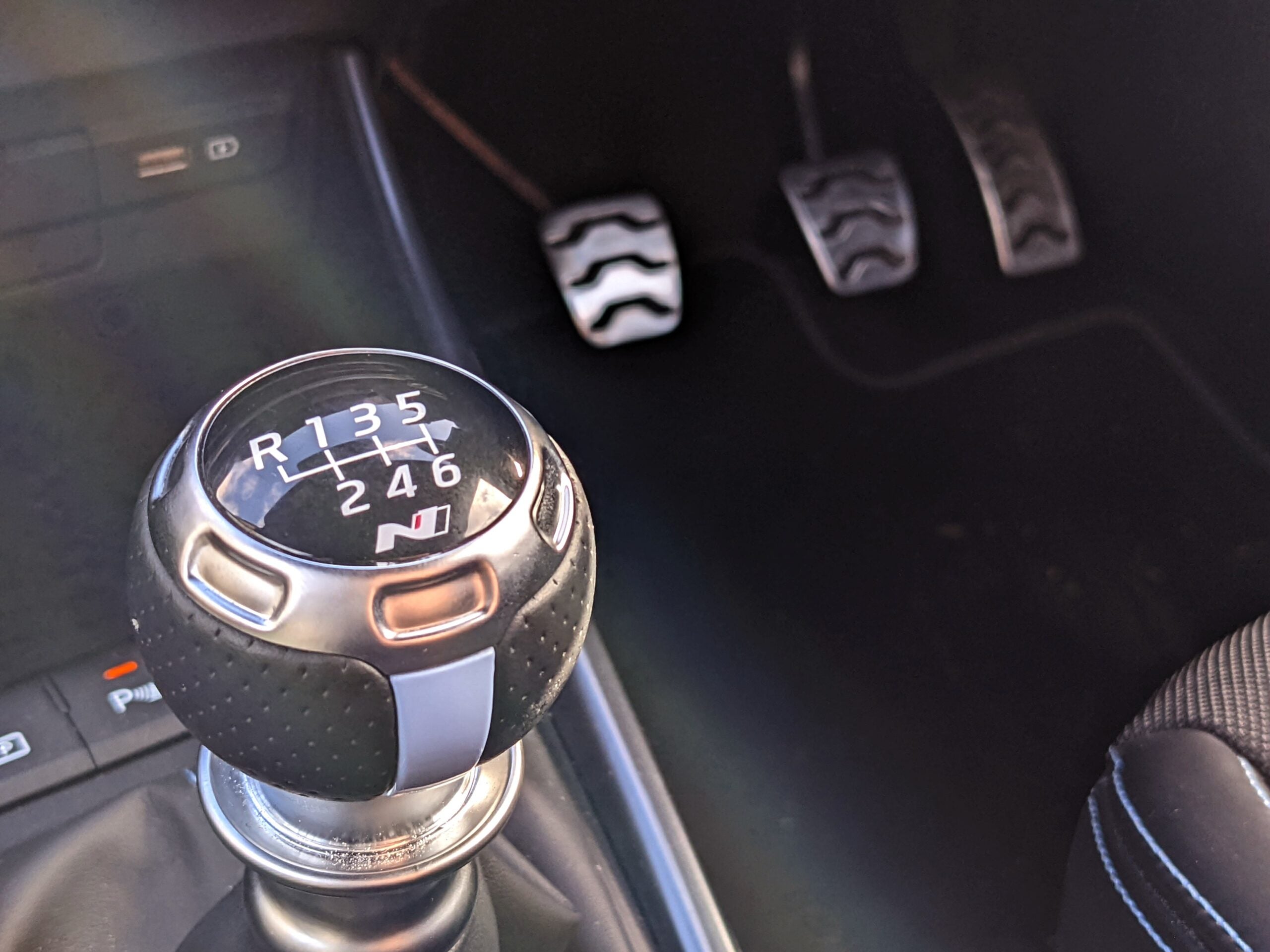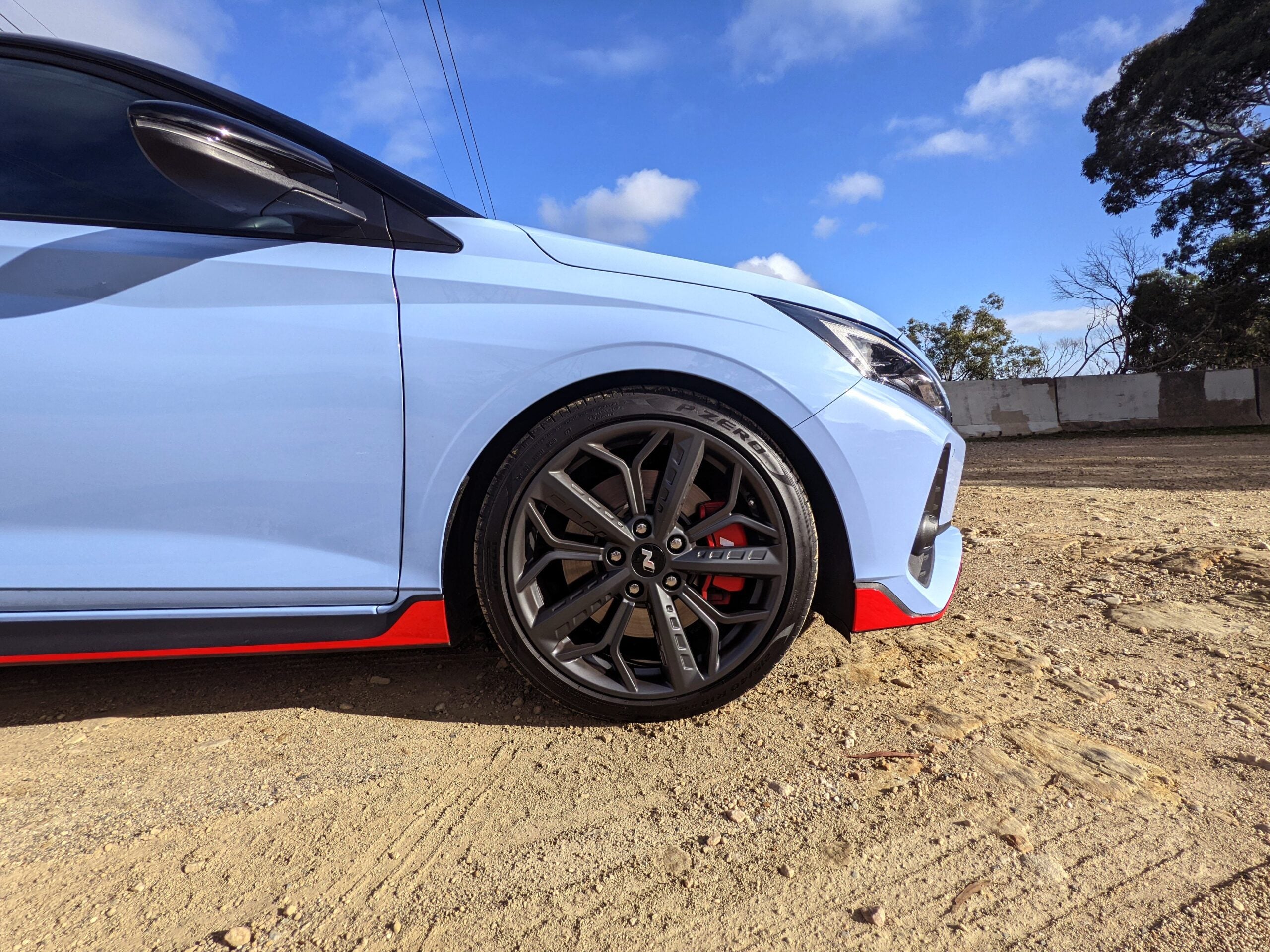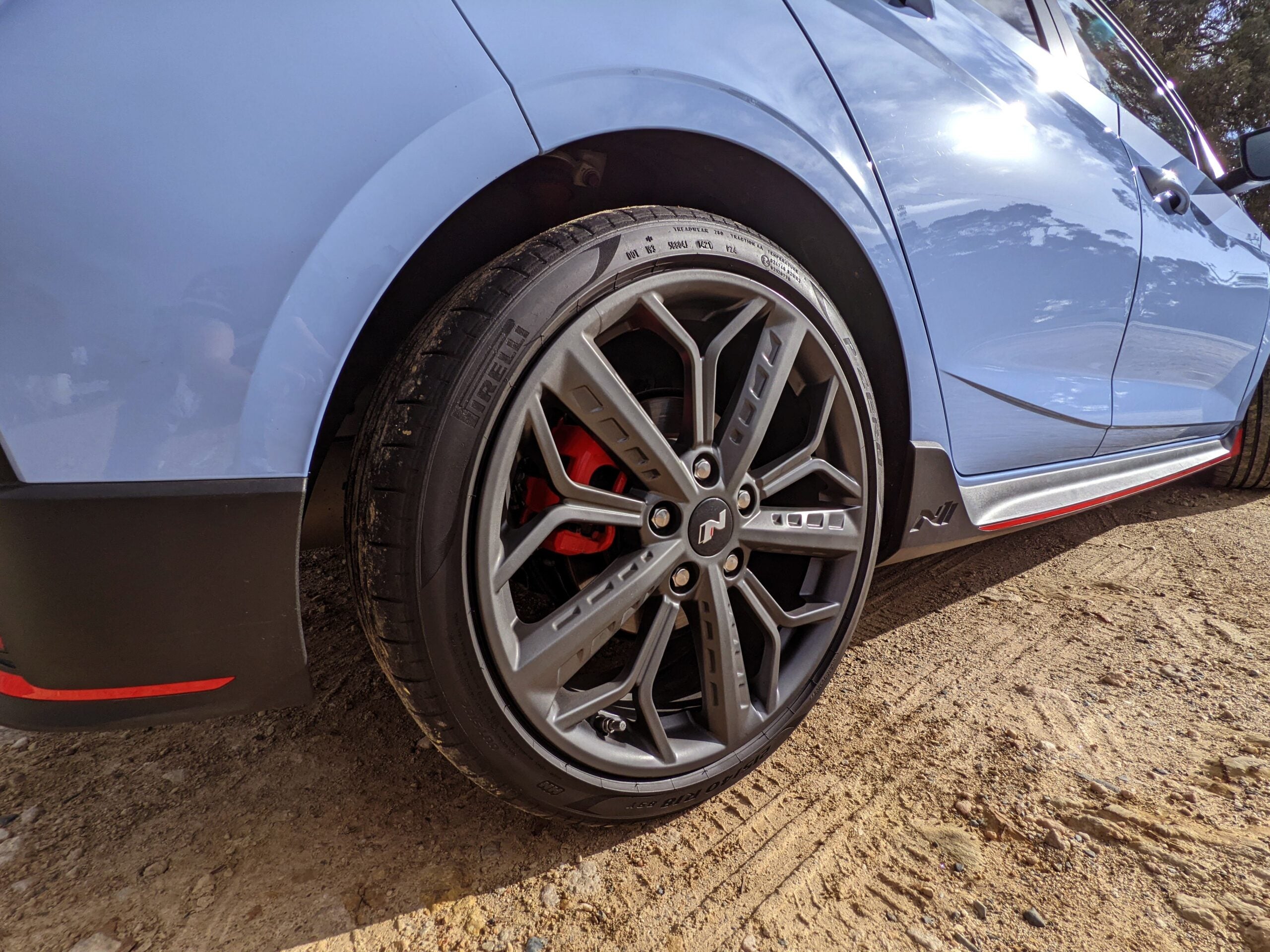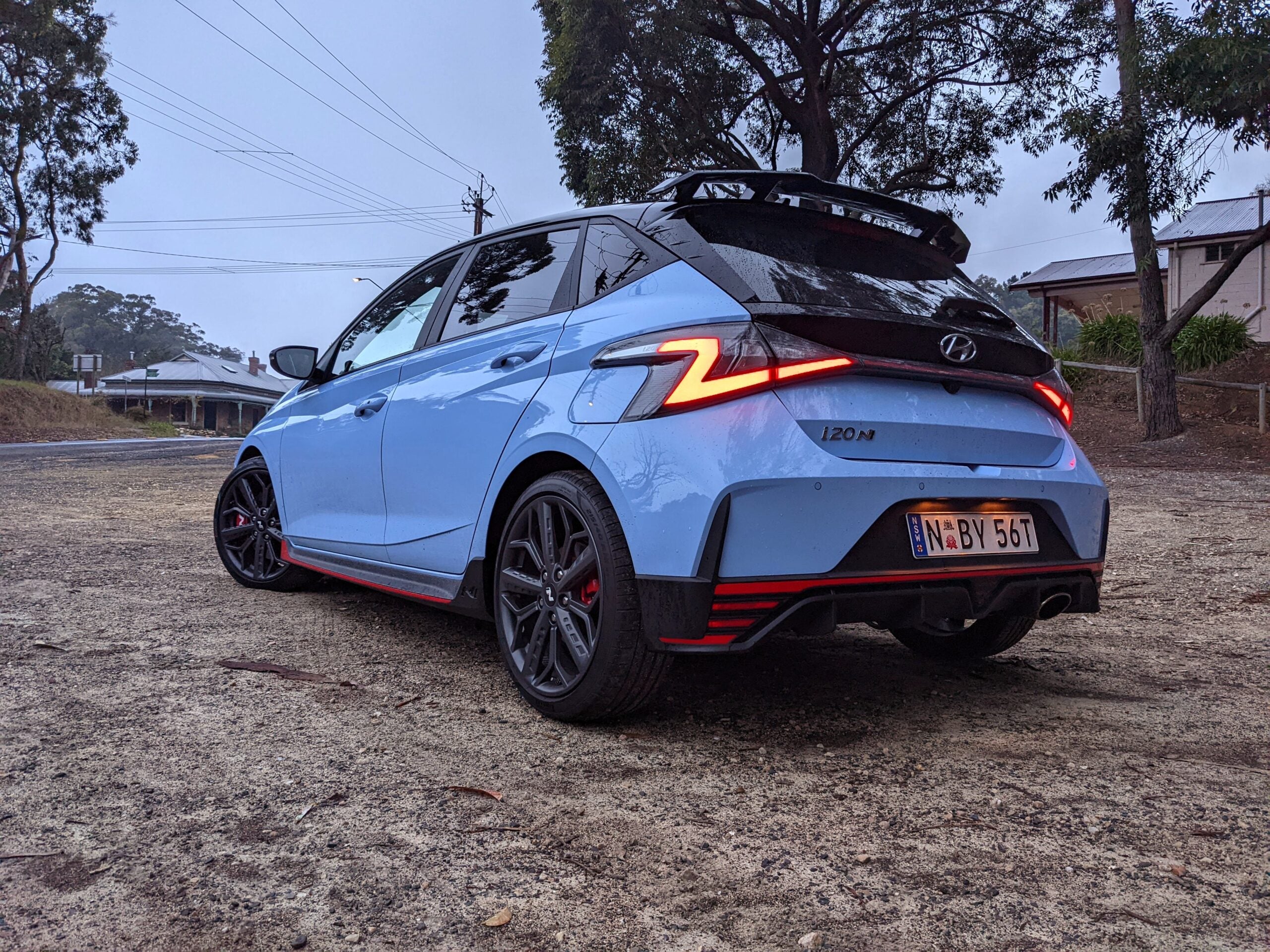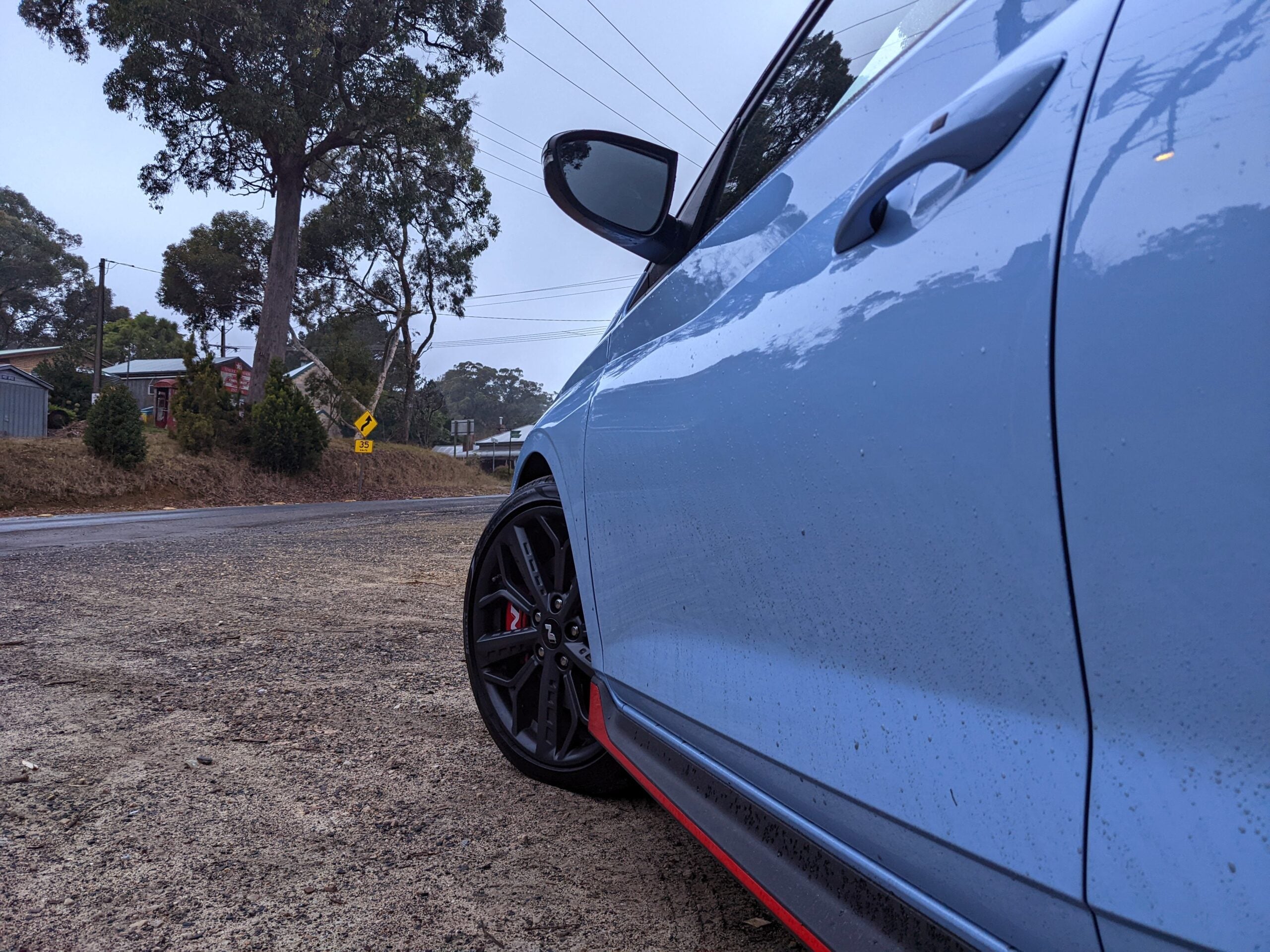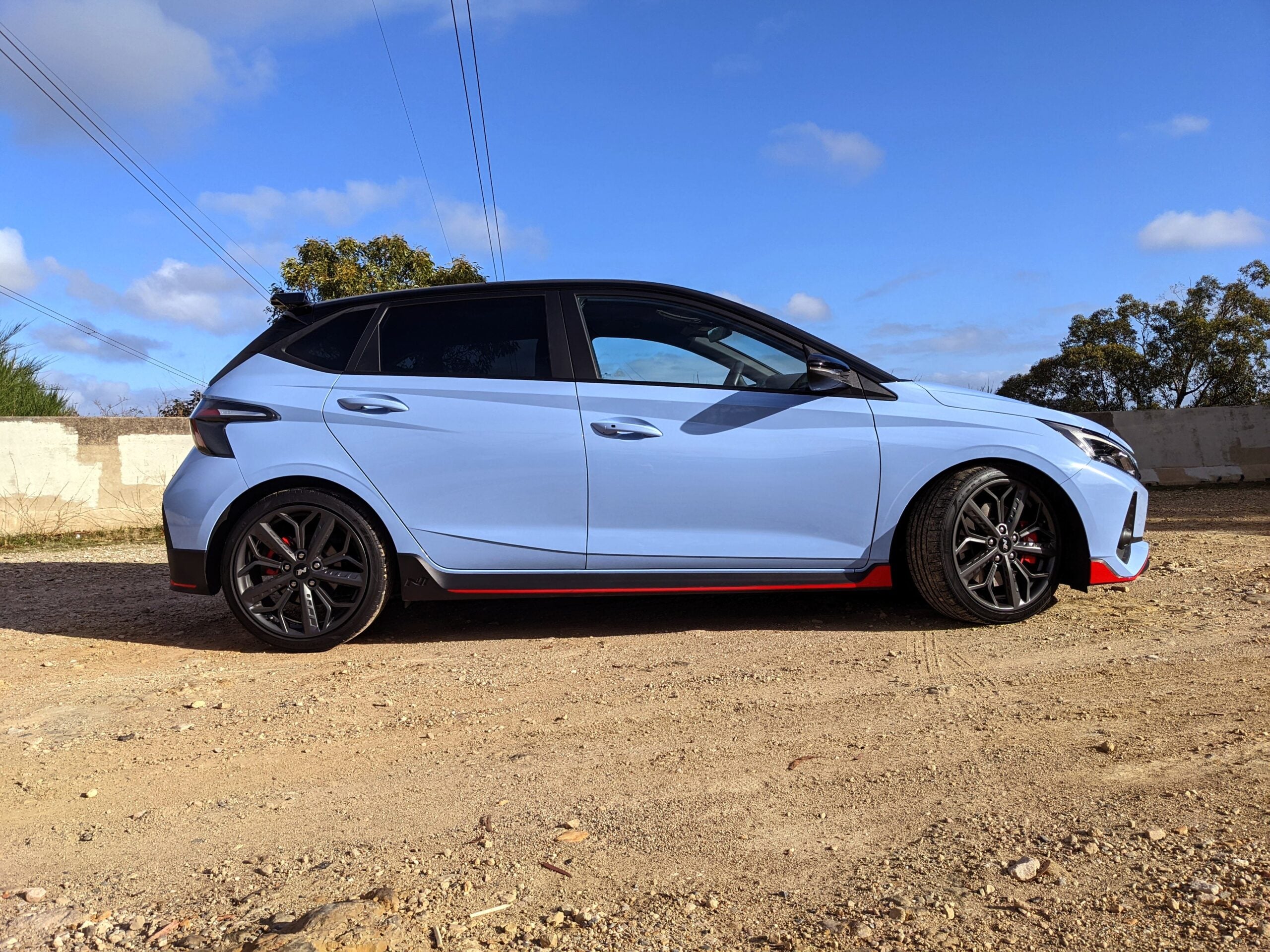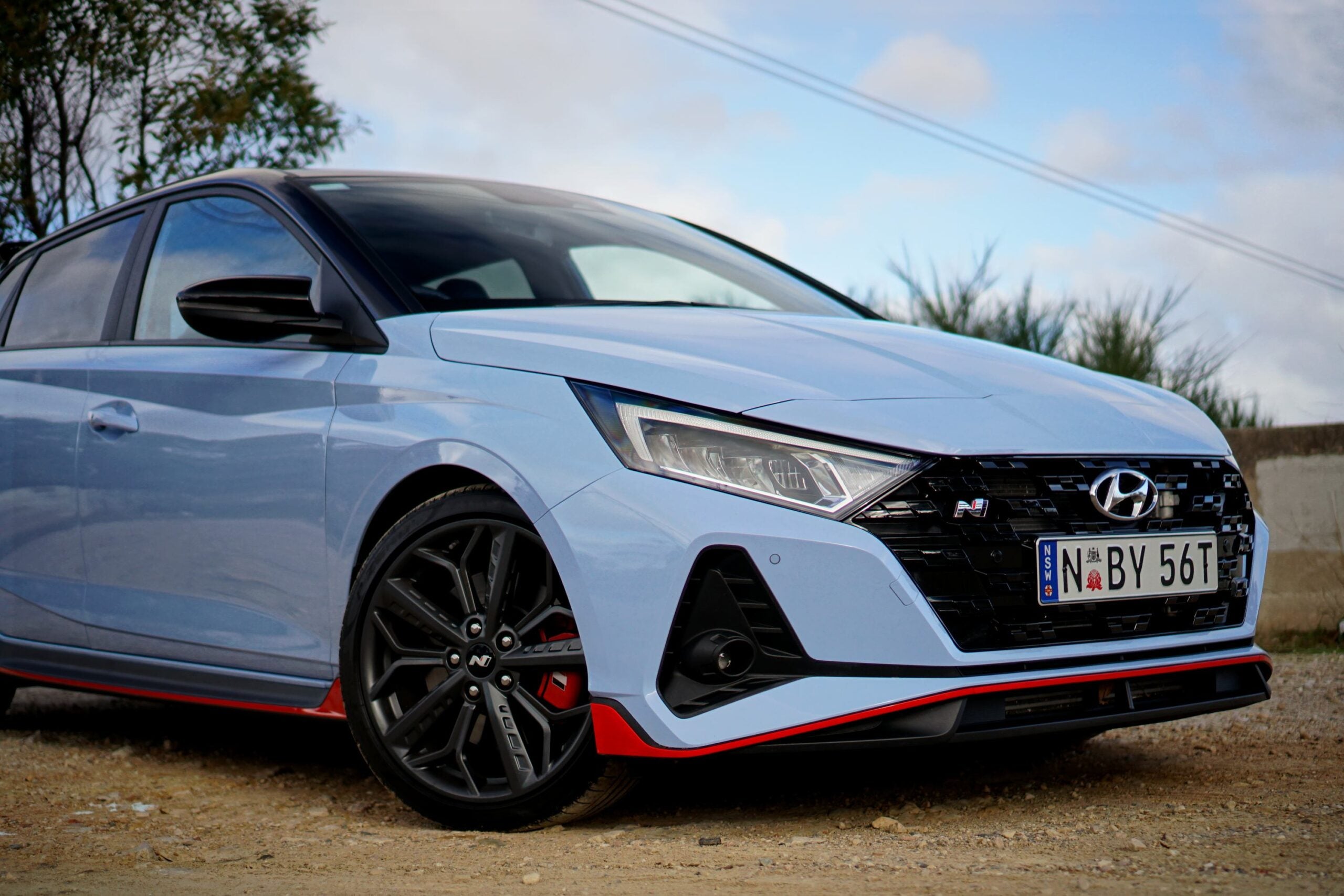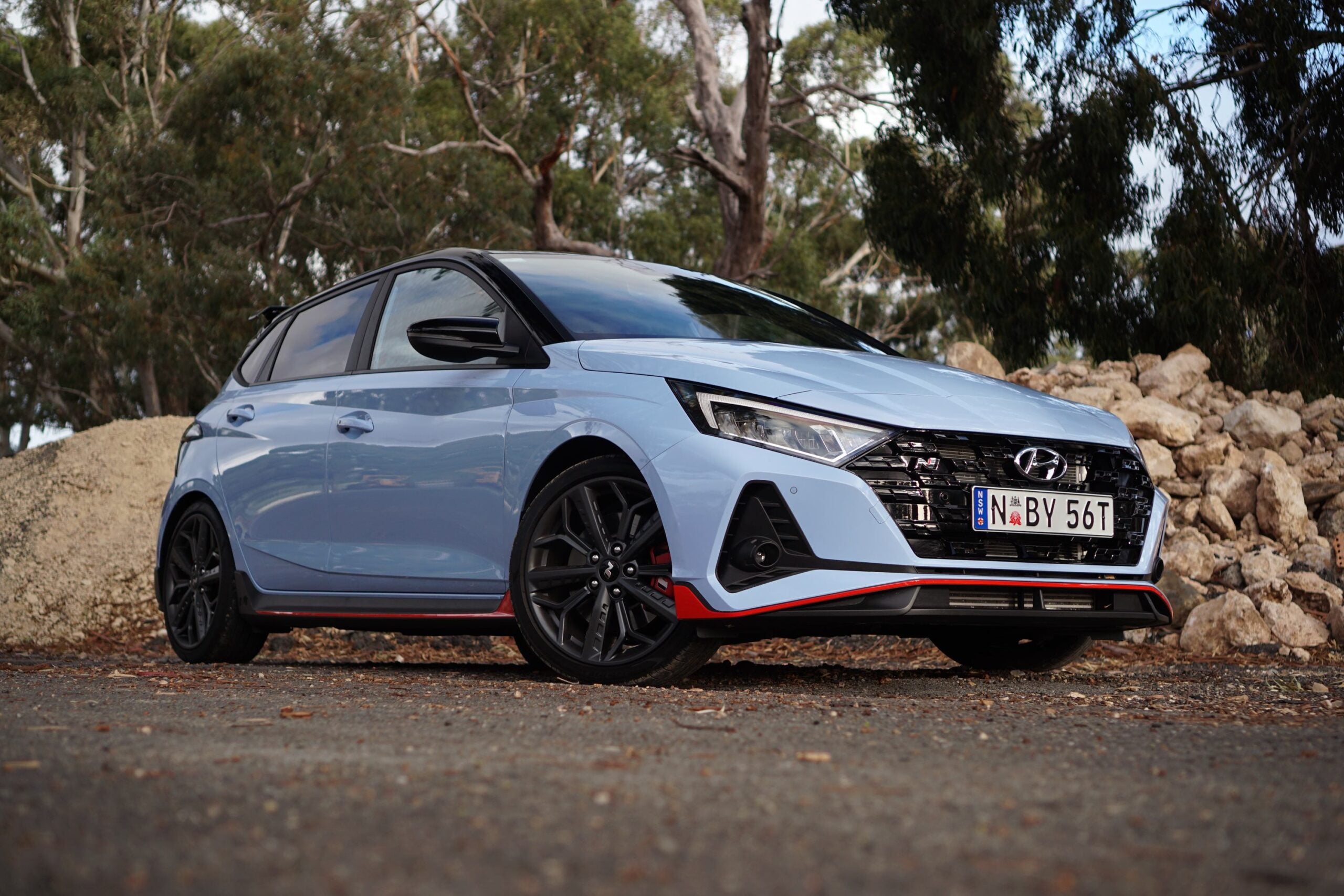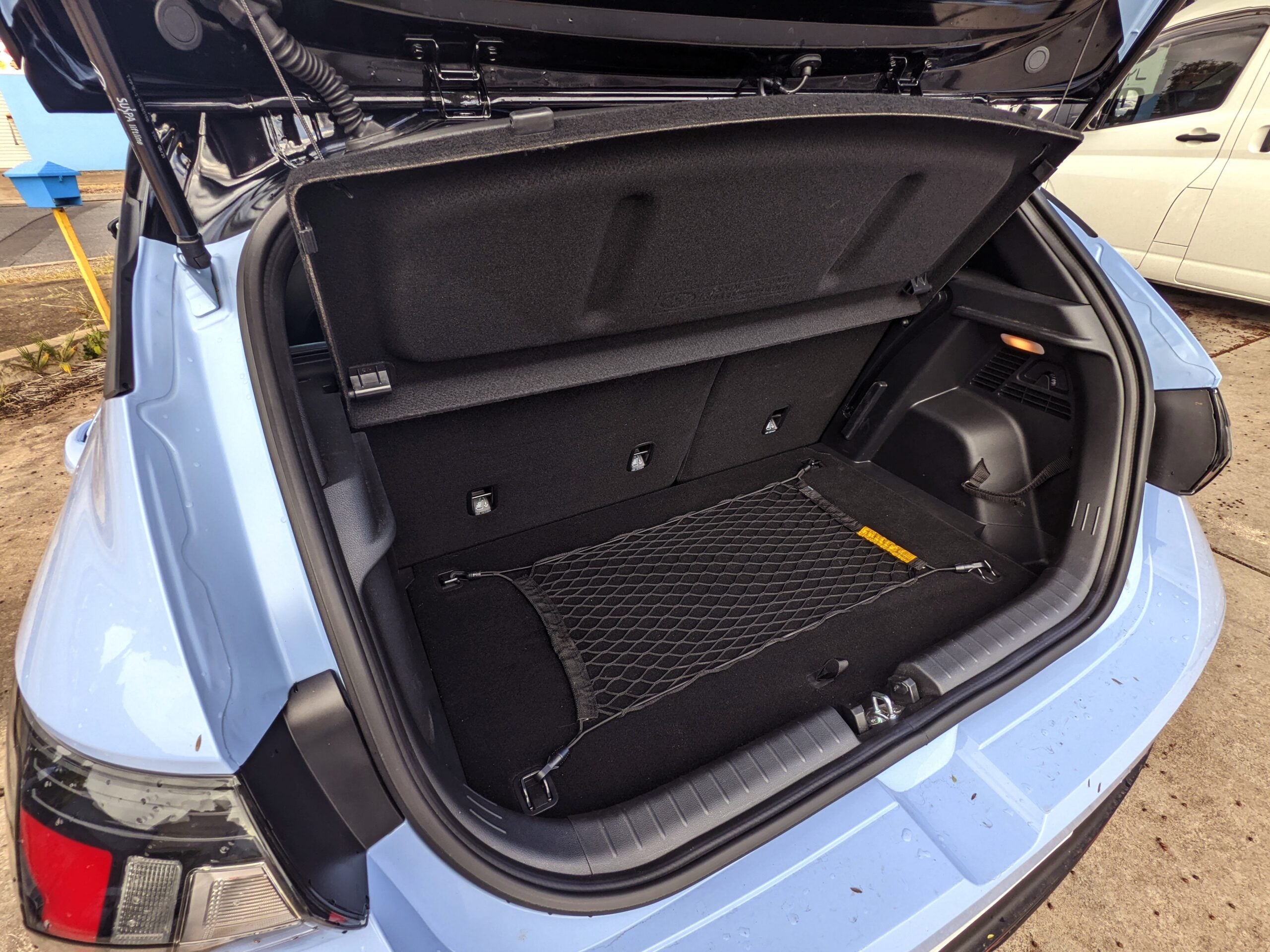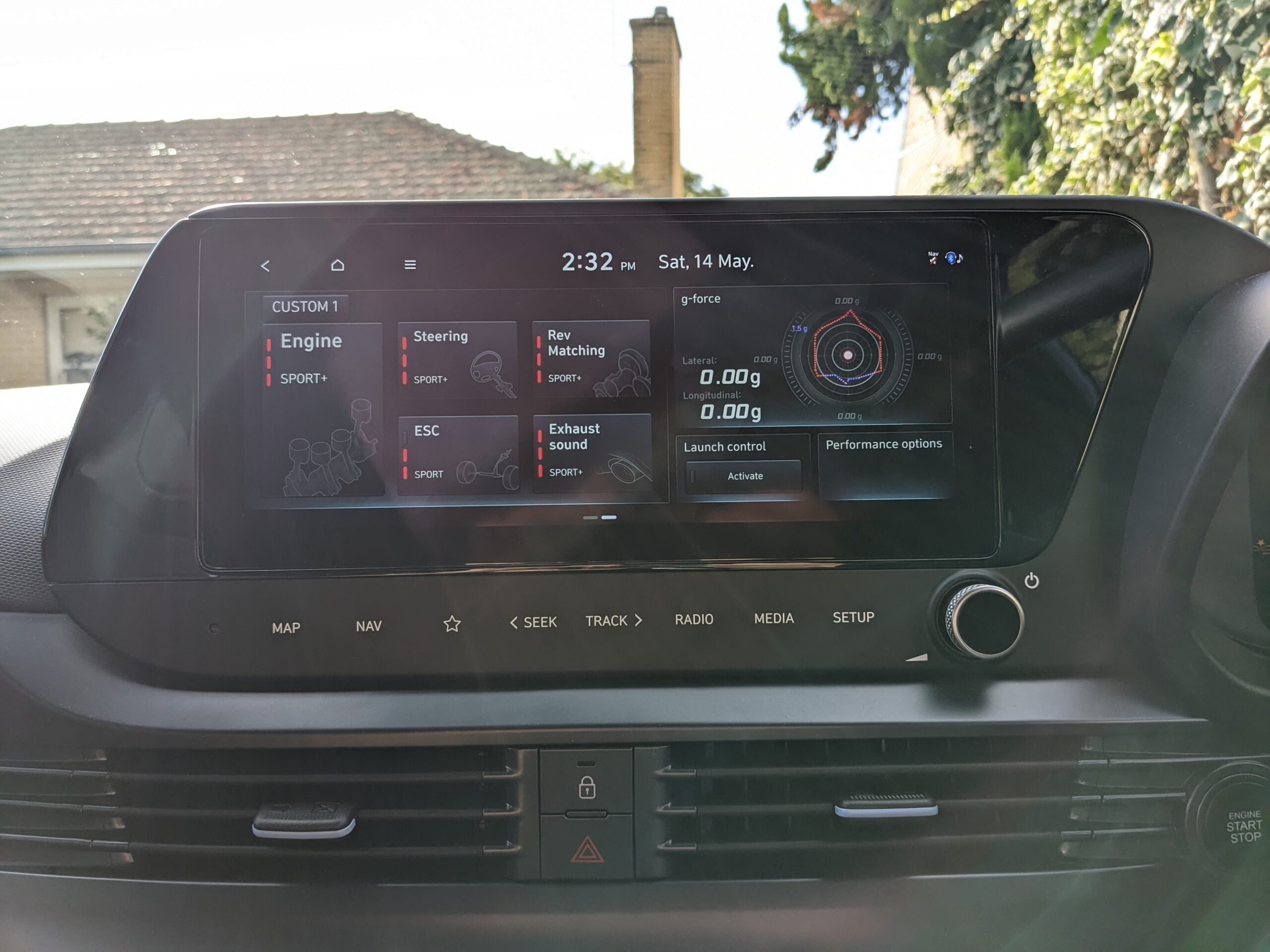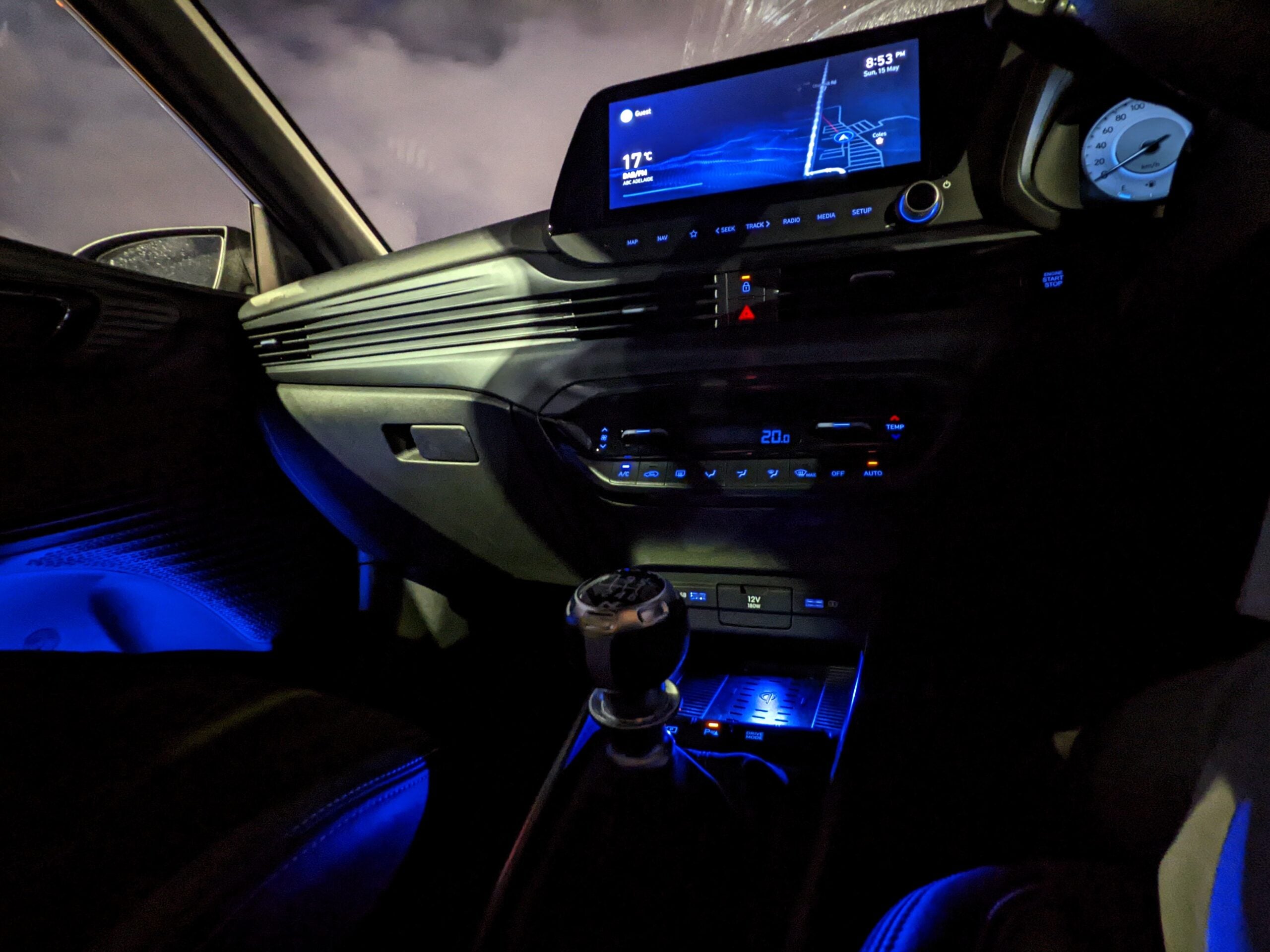In the last two decades, Hyundai has become a fully-fledged automaker, expanding on its traditionally affordable commuter offerings to build out a complete range of vehicles. The 2022 Hyundai i20 N joins that fleet as an entry-level member of the brand’s celebrated N sporting range.
It may be the baby of the N brand in both dimensions and price, but not in attitude. It’s a turbo hot hatch imbued with the personality of a little angry chihuahua, willing to bark and bite at its rivals no matter their size.
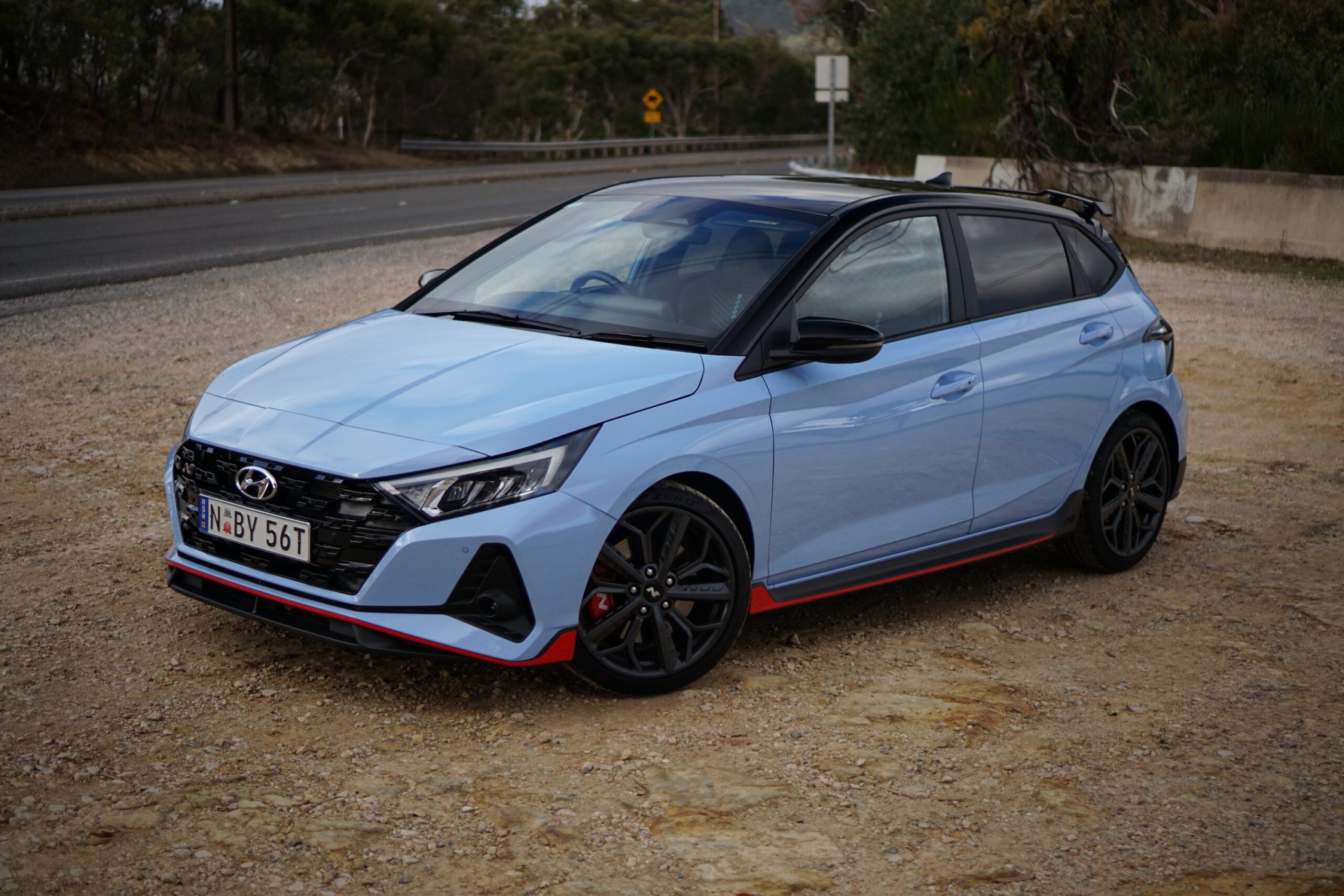
2022 Hyundai i20 N Review Specs
- Base price (as tested): $32,990 AUD ($33,990 AUD)
- Powertrain: 1.6-liter turbocharged four-cylinder | 6-speed manual | front-wheel drive
- Horsepower: 201 @ 6000 rpm
- Torque: 202 lb-ft @ 1,750 to 4,500 rpm
- Curb weight: 2,722 pounds
- 0-60: 6.2 seconds
- Australian fuel economy: 26 mpg urban | 41 extra urban | 34 combined
- Quick take: The track car handling and thrumming engine are always daring you to whip it hard down a back road.
- Score: 8.5/10
The Basics
The base i20 is Hyundai’s second-smallest offering worldwide, sneaking in above the titchy i10 city car. It comes in two major forms: the smaller BI3 chassis covers the Indian market for size-related tax reasons, while the European BC3 covers most of the rest of the world. It’s a simple five-door hatch that’s perfect for grocery runs and getting children to their various schools.
However, when it comes to the i20 N, Hyundai didn’t simply warm it over, slap on some stickers, and call it done. No, to earn that vaunted N badge, the humble hatch got transformed into a surprisingly focused weapon that’s happy to sacrifice comfort for sporting prowess. Walk up and you’ll spot its pedigree at a glance. The low stance, aggressive side skirts, and rear wing all give it away if you somehow missed the plentiful N badges and red trim on the body.
For this specific application, Hyundai dropped in its rorty 1.6-liter turbo-four, good for 201 horsepower, with a bespoke turbo and intercooler, under the hood. The chassis was granted extra reinforcement at 12 crucial points, stiffening it up for more responsive handling and less twist. There are also reinforced top mounts and knuckles in the front suspension to handle spirited driving and high cornering loads better.
Naturally, upgraded shocks, springs, and sway bars play their part by lowering the car significantly and firming up the ride. It’s all combined with a quicker steering rack for a pointier feel. There are bigger brakes, too—a nice touch from Hyundai, like the parent that really just hopes you can stay out of trouble.
On paper, then, it’s clear Hyundai wanted to build a real hot hatch rather than a sticker-pack special. As the photos suggest, it certainly looks the part, but does it hold up when turning a wheel in anger?
Driving the Hyundai i20 N
Open the front door, and you’re reminded just how far Hyundai has come in quality terms from the mid-’90s. There’s a satisfying clunk to the latch, and the door swings open to reveal a comfortable yet sporty interior finished in mostly black. The bolstered seats are near enough to racing buckets and give you the right impression from the get-go. A giant red rev-match button on the sport-trimmed steering wheel is a further reminder of the car’s temperament, and blue backlighting in the doors adds a certain sense of theater.
The show only continues with a touch of the start button. The turbo-four spurts to life with a mischievous, low thrum that feels naughty in the best possible way.
It’s only when you get rolling, though, that you realize Hyundai really did go ham on the i20 N. The clutch is amazingly tight, to the point where I actually stalled the car a couple of times on the first two days of the review. The bite point is surprisingly narrow and engagement is sharp enough that you might struggle at times to pull away lazily from a stop. With only 8,000 km (approximately 4,970 miles) on the clock, though, this is something that might wear in over time.
The suspension is also racier than you might expect. It’s a low car, and the ride is incredibly firm. It’s never crashy or noisy, though, and it feels intimately well controlled. Either way, the handling is more go-kart than family hatch. Paired with the sticky Pirelli P-Zero rubber, it’s a little shocking how much grip it seems to have. Yank on the steering wheel and you’ve got a slalom weapon, helped by the quick-ratio rack that goes a long way to changing the persona of the car.
The i20 N ends up feeling like your friend’s finely fettled track day car, tuned over years for handling and grip to the exclusion of anything else. Of course, that’s precisely what it is, just substitute in the engineers of Hyundai’s N division for that guy you met at the circuit with the surprisingly fast Civic.
Take the i20 N out on a winding road through the hills and you’ll be rewarded for your trouble. It’s a car that knows what it’s built for, and will even prod you to shift into N Mode when the GPS detects an S-bend coming up ahead. Hit the blue button on the wheel and the exhaust opens up, the steering gets weightier and rev-matching is engaged to make sure you shift like a pro. The throttle response is amped up, too, and the daring can also turn off traction control if desired.
In N mode, the i20 N blossoms into its perfect form. You might expect a small displacement turbo engine to suffer from lag, but it pulls hard. Max torque is available from just 1,750 rpm. With grip for days, it’s intoxicating to grab a bootfull of throttle and feel the mechanical LSD yank the car through the back half of a corner. A zero-to-60 time of 6.2 seconds does leave it a little slower than its bigger brother, the i30 N. Similarly, cars like the Volkswagen Golf GTI and Honda Civic Type R will tend to run away in a straight line. When it comes to carving up the canyons, though, there’s more than enough grunt to dip into.
The quick response only makes it all the more enjoyable. It gives the i20 N a feeling like it’s always tugging at the leash, dying to sprint off down the way in pursuit of a distant set of tail lights. It’s a heady thrill, the way you get caught between the dashboard goading you into N mode and the engine daring you to punch it.
Once you’re traveling at a good enough clip, you’ll probably find yourself approaching a corner at some point. It’s then that you’ll reach for the excellent brakes, which come with an exquisite level of pedal-feel. They’ll stop the car hard enough to scare the crap out of your passengers while providing perfect control under use.
Reports from track testing are that the brakes are able to hold up to lap after lap of track abuse without fading, too. That’s likely also a gift of the i20 N’s curb weight of just 2,668 pounds. It’s a featherweight compared to bigger rivals in the hot hatch space, like the i30 N (3,351 pounds) or Golf GTI (3,172 pounds). It comes in lighter than its closer rivals, too, like the Fiesta ST and Polo GTI at 2,782 pounds and 2,832 pounds, respectively.
As a package, the i20 N is a dream to whip along a fast road. There’s not so much power that you’ll scare yourself, but plenty there to enjoy. It’s huge fun to dance the car around, squeezing the pedal just a little more to see how hard the car will stick as you fling it ‘round a sweeper.
Coming hot into the hairpins is where you’ll feel really cool, though. Rev-matching on the downshifts and the stellar anchors will let you go wayyyyy deep under braking. Of course, heel-toe masters can substitute their own skill for the computer as desired.
With the exhaust to N for naughty, it’ll bark nicely on its way up the rev range, though it won’t blow out your eardrums thanks to the well-insulated cabin. The real treats are the rips and crackles when you’re decelerating hard into a corner, perhaps fantasizing that you have some heroic reason to be screaming along at such a rapid pace.
Perhaps most alluring, though, is the purring growl when that performance motor is humming at a stop. It’s a proper tuner-car sound, and it inspires you to give other meeker road users the evil eye from behind your expensive sunglasses. Even better is the way the idle lifts menacingly when you first touch the N button.
The whole feel of the car is that it’s built for attack. One could imagine that shaving down lap times week after week at the track would be a very satisfying experience as one learned the car. It’s short of a roll cage and fire extinguisher, but that’s about all it really needs to be a track day special. Make a few suspension mods and add a little ground clearance and you’d have a road rally weapon, too.
That razor-sharp feel does come at a cost, though. As the most budget-friendly member of the N family, the i20 N isn’t full of fancy active suspension that can soften up on demand. The only transmission option is the six-speed manual.
Thus, the i20 N can be a little bit out of sorts when it comes to daily duties. Eco mode or even Normal will calm the engine down and quell the exhaust to reasonable levels. However, it’s still a car that wants to go at heart. The suspension remains firm no matter the situation, and you’ll want to be cautious around speed bumps and driveways if you want to avoid scraping the front lip.
The clutch is where you’ll find the most frustration on a day-to-day basis. Perhaps it calms down after the first 10,000 miles, but it remained tight as a drum during my week-long test. It’s a car you wouldn’t want to get stuck in stop-start traffic, nor regularly back out of a steep driveway. It’s finicky enough to be annoying in these conditions.
Other than the dynamics, though, the i20 N acquits itself well in daily life. There’s plenty of room for four or five passengers, and the five-door body style makes getting in and out a breeze. The boot is small but well-proportioned with a nice low load height. If anything, this makes loading in groceries easier as there’s less space for them to roll around. If you need to move something bigger, you can always drop the back seats down.
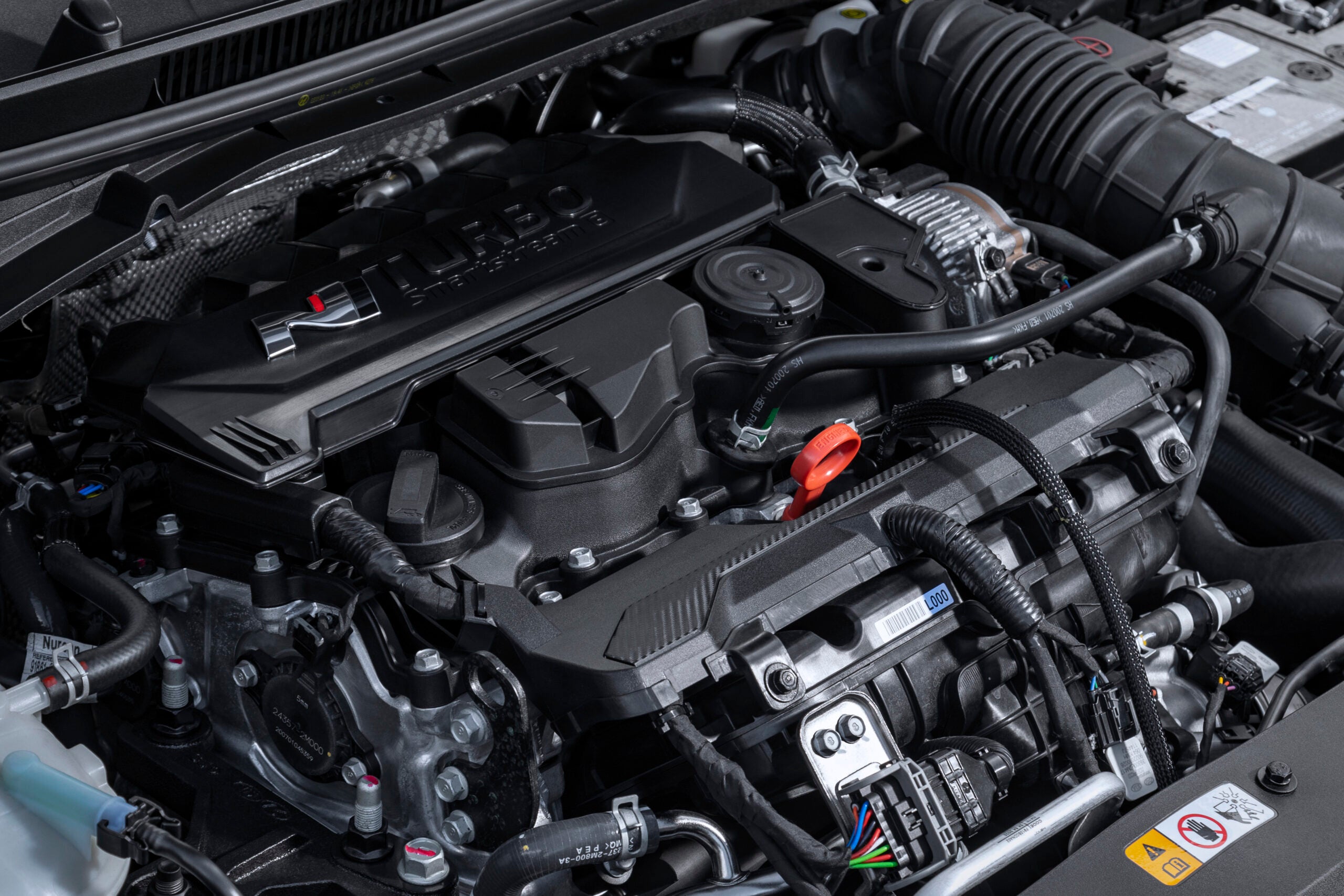
The Highs and Lows
Aesthetically, the i20 N is an absolute delight. It looks the business, for lack of a better term. It’s a car you can’t miss in Performance Blue with the on-trend black roof and pillars delivering a chic two-tone effect. The bodykit, finished in gray and red, takes things up another notch in intensity. Hyundai has created its own visual style that screams performance without hitting on tired JDM tuner tropes from yesteryear. This is a Korean take on what a hot hatch should be, and a shining example of the Hyundai N design language.
Inside, the i20 N is well-appointed, with materials and finishes that feel right for a hot hatch. There aren’t any major missteps like slippery leather seats or obviously cheap plastics that fall to hand. The seats are perfect for hugging you in the turns, though larger-bodied drivers would do well to check they’re comfortable before committing to the purchase.

The infotainment system does have some curious quirks, though. Most of the time, it’s used in a two-pane mode. This allows you to view the navigation system while also seeing what’s playing on the radio, for example. However, all too often, it would fall into displaying maps on both panes, which is visually maddening to look at. A simple swipe fixes the problem but it shouldn’t really be an option in the first place.
The digital dash cluster does a decent job. It’s at its best in N mode, where the tachometer and speedometer are both in their most legible format. In comparison, the white-backed simulated gauges of Normal mode are difficult to read at a glance. I found myself relying on the numerical speed display instead, which took up space that would otherwise display useful data like trip distances or fuel economy metrics. A head-up display would be a great addition here, even if it only displayed speed.
The power windows are nice, and operate smoothly and quickly without a lot of fuss. However, it’s 2022, and I was disappointed to find that only the driver’s window had the auto up/down feature. Alas!
Cruise control is present and accounted for, along with the typical lane-keeping and lane departure warning systems. With that said, don’t get caught out: there’s no radar cruise available. You’re 100 percent responsible for braking in the i20 N, so don’t you forget it. I, uh… you know what? Never mind.
Competition and the Market
The test car was given the hero colors: Performance Blue body, with the $1,000 black contrasting roof finish. It’s the only option available on the i20 N, along with a $595 premium paint charge for Dragon Red or Phantom Black on the body.
As far as the competition goes, the Hyundai i20 N holds a unique position in the compact hot hatch marketplace, selling at $32,990 AUD MSRP before on-road costs. In Australia, at least, it comes in at a similar price point to both the Ford Fiesta ST ($33,490 AUD) and well cheaper than the VW Polo GTI ($38,750 AUD).
Compared to its rivals, the i20N goes the furthest towards performance over comfort. All three cars post similar power figures of around 200 hp, weigh about the same, and come as five-door hatches. But it’s the Hyundai that goes balls-to-the-wall with the track-ready brakes and suspension tune, super-pointy handling, and gooey, sticky rubber.
The rivals might be nicer for taking grandma down the shops, it’s true. But if you want a car that’s going to up your pulse on a regular basis, the i20 N is the one to choose. Between the hot blue paint and the lairy body kit, it’s the bad influence friend that’s always pushing you to just have a bit of a go.
Value and Verdict
The i20 N is a car that flirts with you in an attempt to get you to push its buttons… its N buttons, that is. In this respect, it’s better at eliciting a response than even loftier rides like Toyota’s much-celebrated GR Yaris. If that’s the kind of thrill you want out of life, the i20 N’s the one for you.
Overall, it’s a car to be celebrated. Hyundai could have simply warmed over the engine and thrown some stickers on the i20 and called it a day. Instead, it went hard and built a car that any teenager would get into all kinds of trouble with. For those of us a little more mature, it’s a car that reminds us not to be afraid to move that needle into the red now and then.
Got a tip? Let the author know: [email protected]
